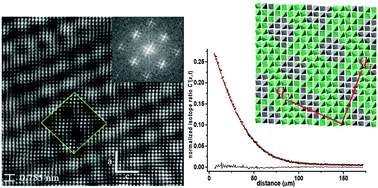Room temperature structure and transport properties of the incommensurate modulated LaNb0.88W0.12O4.06†
Abstract
The crystal structure of a (3 + 2)D incommensurate modulated LaNb0.88W0.12O4.06 phase, a novel oxygen ionic conductor, is refined using a combination of synchrotron X-ray diffraction and electron diffraction data. The superspace group I2/c(α10γ1)00(α20γ2)00 (a = 5.4131(1) Å, b = 11.6432(2) Å, c = 5.2963(1) Å, β = 91.540(1)°, q1 = 0.2847(5)a* + 0.1098(9)c* and q2= −0.1266(9)a* + 0.2953(1)c*) was chosen for the refinement. Similar to other scheelite type modulated structures, the modulation of LaNb0.88W0.12O4.06 stems from the cation occupancy ordering in the xz plane. To facilitate the modulated cation sub-lattice, and to compensate for the difference in their size and charge, the B site polyhedra are distorted by stretching the B–O bond lengths. Consequently, an extension in the B site coordination number from 6 to 8 is observed in the modulated phase. An interconnected 3D network of BOx polyhedra, similar to that of modulated CeNbO4.25, is obtained as a result of the structure modulation, which is not available in the unmodulated parent structure. Tracer diffusivity measurements indicate that the composition is an oxygen ion conductor, which relies on an intersticalcy conduction mechanism. Oxygen tracer diffusivity of 2.46 × 10−9 cm2 s−1, at 750 °C is reported.



 Please wait while we load your content...
Please wait while we load your content...